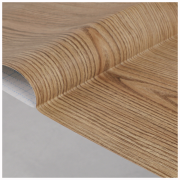What is the principle of vacuum plasticization of PVC decorative films?
The principle of vacuum plasticization of PVC decorative films involves the use of heat and pressure to soften and shape the PVC material.
The process begins by heating the PVC decorative film, which is typically in sheet or roll form, to a specific temperature range. This temperature is typically above the glass transition temperature of PVC, which is around 70-90°C.
Once heated, the PVC film is placed over a mold or substrate with the desired shape or texture. The mold is usually made of metal or another heat-conductive material and may have a textured surface to create a specific design or pattern on the PVC film.
During the heating and softening process, the PVC film is placed close to the medium density fiberboard after spraying adhesive. The air between the PVC film and the medium density fiberboard adhesive film is extracted using vacuum, and the PVC film is tightly adhered to the medium density fiberboard using atmospheric pressure. This process is called vacuum plasticizing.
Characteristics of PVC blister film:
The adhesive used for vacuum plastic film application is vacuum plastic, which is mainly water-based polyurethane adhesive and mixed with other resins. In principle, hot melt adhesive or solvent based adhesive can also be used, but water-based adhesive is non-toxic, odorless, affordable, and suitable for mechanized operation.
The biggest feature of this process is that it does not require further painting or coating, and it is a paintless process. In addition, it can also cover concave and convex grooves, curved edges, and hollow carving pieces, which are incomparable to other processes.
A vacuum is then applied to the backside of the PVC film, which helps to create a pressure difference between the two sides of the film. This pressure difference forces the softened PVC material to conform to the shape of the mold or substrate.
As the vacuum is applied, the air trapped between the PVC film and the mold is removed, creating a tight seal between the film and the mold surface. This allows the PVC material to closely adhere to the mold and take on its shape.
Once the PVC film has completely conformed to the mold, the vacuum is released, and the film is cooled rapidly to solidify the material and maintain its shape. This cooling process can be done using water or air, depending on the specific requirements of the application.
The end result is a decorative film that has been transformed into a specific shape or texture, ready to be used for various applications such as furniture, interior design, or automotive trim.PVC decorative film has a discounted price and is easy to use, making it highly popular in markets around the world. If you encounter any problems or confusion when selecting PVC decorative films, please feel free to contact us at ECO PVC FILM, and we will provide you with the best service and quality. The super high cost-effectiveness will make you 100% satisfied.








